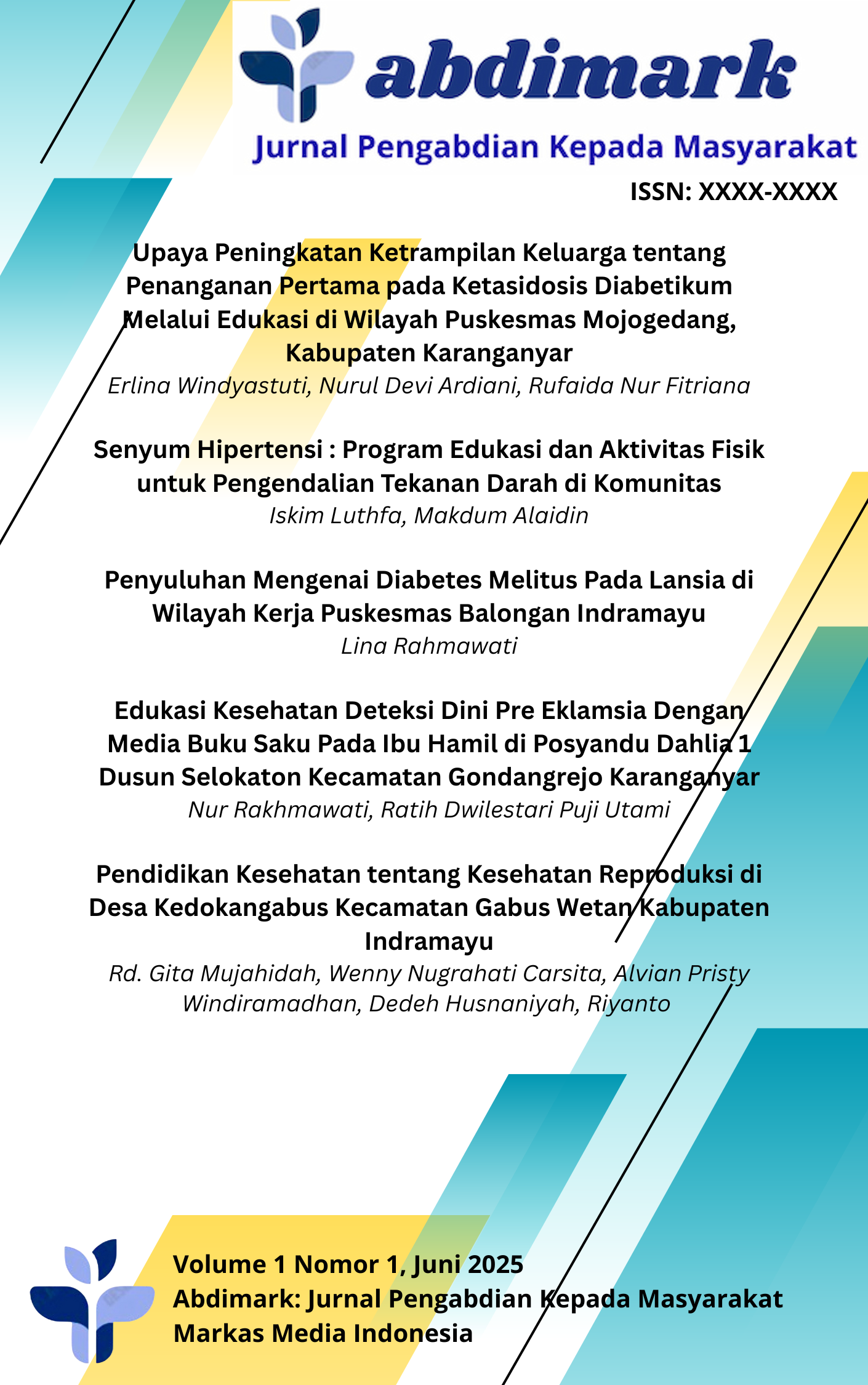Senyum Hipertensi : Program Edukasi dan Aktivitas Fisik untuk Pengendalian Tekanan Darah di Komunitas
Keywords:
Hypertension, Health Education, Hypertension Exercise, Community Empowerment, Community EngagementAbstract
Hypertension is one of the most prevalent non-communicable diseases in the community and is often undetected due to its asymptomatic nature, earning it the nickname “silent killer.” Health mapping conducted in RW 08, Bangetayu Wetan Subdistrict, revealed a high number of residents with elevated blood pressure and limited knowledge regarding hypertension prevention and management. This community engagement program aimed to improve public knowledge, attitudes, and behaviors related to hypertension control through an integrated intervention of health education and physical activity. The activities included health education sessions, distribution of educational leaflets, medical screenings (blood pressure, blood glucose, cholesterol, and uric acid), and routine hypertension exercise sessions. The target population consisted of adults and the elderly. Evaluation was conducted using pre- and post-intervention measurements of knowledge, attitudes, behaviors, and blood pressure. The results showed a significant improvement in participants’ knowledge (from 15.38% to 58.24%), positive attitudes (from 12.09% to 56.04%), and healthy behaviors (from 15.38% to 59.34%). The average blood pressure also decreased from 160.6/98.5 mmHg to 148.9/88.5 mmHg. In conclusion, the “SENYUM HIPERTENSI” program was proven effective as a promotive and preventive model for improving health literacy and blood pressure control at the community level. Similar interventions are recommended for replication in other areas with a high prevalence of hypertension.
Downloads
References
American Heart Association. (2024). Understanding your blood pressure readings. https://www.heart.org/en/health-topics/high-blood-pressure
Dinas Kesehatan Kota Semarang. (2024). Profil kesehatan masyarakat Kota Semarang tahun 2024. Semarang: Dinas Kesehatan Kota Semarang.
European Society of Cardiology. (2022). 2022 ESC guidelines on the management of arterial hypertension. European Heart Journal, 43(44), 4279–4381. https://doi.org/10.1093/eurheartj/ehac509
Green, L. W., & Kreuter, M. W. (2005). Health program planning: An educational and ecological approach (4th ed.). McGraw-Hill.
International Society of Hypertension. (2024). ISH Global Hypertension Practice Guidelines. Journal of Hypertension, 42(6), 1012–1043. https://doi.org/10.1097/HJH.0000000000003450
Kementerian Kesehatan Republik Indonesia. (2023). Laporan Survei Kesehatan Nasional 2023: Prevalensi Penyakit Tidak Menular. Jakarta: Badan Penelitian dan Pengembangan Kesehatan.
Lee, Y., & Kim, Y. (2021). The effectiveness of educational programs on hypertension management: A systematic review and meta-analysis. Journal of Clinical Nursing, 30(5–6), 724–738. https://doi.org/10.1111/jocn.15678
Mills, K. T., Stefanescu, A., & He, J. (2020). The global epidemiology of hypertension. Nature Reviews Nephrology, 16(4), 223–237. https://doi.org/10.1038/s41581-019-0244-2
Nguyen, H. Q., Ha, D. A., Goldberg, R. J., Moorthy, M. V., & Yancy, C. W. (2022). Community-based interventions for blood pressure control: A global perspective. Current Hypertension Reports, 24(1), 25–34. https://doi.org/10.1007/s11906-022-01143-9
Pescatello, L. S., Arena, R., Riebe, D., & Thompson, P. D. (2015). ACSM's guidelines for exercise testing and prescription (9th ed.). Wolters Kluwer/Lippincott Williams & Wilkins.
Trihastuti, A., & Wulandari, R. A. (2021). Pengaruh senam hipertensi terhadap penurunan tekanan darah pada lansia penderita hipertensi. Jurnal Keperawatan Soedirman, 16(2), 115–122. https://doi.org/10.20884/1.jks.2021.16.2.4321
World Health Organization. (2023). Global report on hypertension: The race against a silent killer. Geneva: WHO. https://www.who.int/publications/i/item/9789240081494


